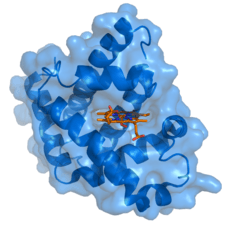Ligand facts for kids
A ligand is a special kind of substance in biology. Think of it like a key that fits into a lock. Its main job is to attach, or "bind," to a biological molecule, often a protein. When a ligand binds, it makes that molecule do something specific.
This binding changes the shape of the molecule it attaches to. This change in shape then affects how the molecule works. For example, it might turn a process on or off.
Ligands attach using different types of weak forces. These include ionic bonds, hydrogen bonds, and van der Waals forces. This attachment, or "docking," is usually temporary. The ligand can attach and then detach again.
Many important substances in your body are ligands. These include substrates (molecules that enzymes act on), inhibitors (which slow down reactions), activators (which speed up reactions), and neurotransmitters (brain chemicals). The strength of how well a ligand binds is called its affinity.
Contents
What Are Ligands?
Ligands are like messengers or switches in your body. They are small molecules that connect with larger ones. These larger molecules are often proteins. When a ligand connects, it sends a signal. This signal tells the protein what to do.
Imagine a remote control for a TV. The remote is the ligand. The TV is the protein. When you press a button (the ligand binding), the TV changes channels or turns on.
How Ligands Work
When a ligand meets its target protein, it fits into a special spot. This spot is called a binding site. It's like a puzzle piece fitting perfectly into its place. This connection is very specific. Only the right ligand can bind to the right protein.
Changing Protein Shape
Once a ligand binds, it causes a small change in the protein's shape. This change is often very tiny. But even a small change can have a big effect. It can make the protein active or inactive. It can also change what the protein does. This is how signals are sent and actions are controlled inside your cells.
Why Ligands Matter
Ligands are super important for almost everything that happens in your body. They help your cells communicate. They control many body functions. Without ligands, your body wouldn't be able to work properly.
Ligands in Your Body
Many things you hear about in biology are ligands.
- Hormones are ligands. For example, insulin is a hormone that tells your cells to take in sugar.
- Neurotransmitters are ligands. These are chemicals that send signals between nerve cells in your brain. They control your mood, learning, and movement.
- Enzymes also use ligands. A molecule that an enzyme acts on is called a substrate. The substrate is a ligand for that enzyme.
Ligands and Medicines
Many medicines work by acting as ligands. They are designed to bind to specific proteins in your body.
- Some medicines act like natural ligands. They turn on a process that your body needs.
- Other medicines block natural ligands. They stop a process that is causing problems. This is how many pain relievers or allergy medicines work.
Different Kinds of Ligands
Ligands can do different jobs depending on their role.
- Substrates are ligands that enzymes change into new products.
- Inhibitors are ligands that stop or slow down a protein's activity.
- Activators are ligands that turn on or speed up a protein's activity.
How Strong is the Binding?
The strength of the connection between a ligand and its protein is called affinity. Some ligands bind very strongly. Others bind more weakly. This strength affects how long the ligand stays attached. It also affects how much of the ligand is needed to cause an effect. High affinity means a strong, tight fit. Low affinity means a weaker, looser fit.
Related pages
Images for kids
-
Cobalt(III) complex containing six ammonia ligands, which are monodentate. The chloride is not a ligand.
See also
 In Spanish: Ligando para niños
In Spanish: Ligando para niños




